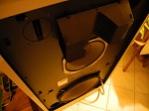Building a 5-way active system is no easy task!
You have to take extra care about phase coherency and the effect of one crossover point on the others:
http://www.linkwitzlab.com/frontiers_5.htm#V
So for example in your case I suppose you are using different channels of your 4x10 for the sub, woofer and mid+cd+tweet.
So that means that if you are using 24dB/oct filters for the sub/woofer crossover then you should add a 80Hz 2nd order allpass filter to the mid+cd+tweet section.
If you go fully active you will have to add allpasses on all channels but, reflecting crossovers from the lower channels.



 Reply With Quote
Reply With Quote


 This will be quite the undertaking for a noob, but I figure it will probably be the biggest improvement that can be done to this system. This is all very exciting because with DSP you get instant gratification, haha.
This will be quite the undertaking for a noob, but I figure it will probably be the biggest improvement that can be done to this system. This is all very exciting because with DSP you get instant gratification, haha.
